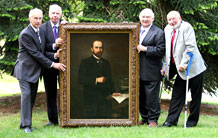
Leo Kamm's grandchildren (Steve, Nick, Laurence and Paul) delivering the oil painting to the University of Exeter
Pioneer of film technology immortalised at cinema museum
The inventor of one of the first cameras and projectors for moving images patented in the UK has been immortalised in an oil painting which has been donated to the University of Exeter’s cinema museum.
Leo Kamm was one of the pioneers of cinema technology in Britain and the inventor of the Kammatograph, a filmless camera and projector that used glass plates to capture images and show them to an audience. It was patented in 1898, two years after the first demonstration of Lumière’s cinematograph in Britain. The Kammatograph used a system of glass discs with a mechanism that produced a spiral row of pictures. It was enclosed in a box that was attached to a magic lantern to project the pictures that edged the glass discs and proved popular for a few years around the turn of the last century.
His grandchildren, the four Kamm brothers, Paul, Nick, Steve and Laurence, are donating an oil painting of Leo with one of his inventions to the Bill Douglas Centre, the University of Exeter’s cinema museum, where it can be viewed by the public.
Phil Wickham, Curator of the Bill Douglas Centre, said; “We are delighted to receive this generous donation from the Kamm family of a painting of their grandfather. We already have one of the best collections of early cinema artefacts and ephemera in the UK, put together by the filmmaker Bill Douglas and his friend Peter Jewell. This oil painting is a great addition to our holdings, shedding light on an alternative course that cinema might have taken.”
Leo Kamm, who had come to London from Germany, later embraced film and ran a very successful projection and photographic family business for many years. He produced a full range of electrical equipment, from film projectors to typewriters, and in 1907, at a time when moving pictures were becoming immensely popular, was selling all kinds of moving picture apparatus from his office in Cecil Court, London, then the centre of the British film industry.
The Kamm Brothers said: “This is a very important object within our family and we are very proud of our grandfather’s role in cinema history in the UK. We are very pleased to donate this picture to the Bill Douglas Centre so that the public can find out more about him, and his ingenious invention, the Kammatograph”.
Dr Joe Kember, Senior Lecturer in film at the University of Exeter, said: “Leo is best remembered for the Kammatograph, a device which promised to overcome the fire hazards associated in the first years of cinema with inflammable celluloid film. It was sold for several years from 1900, bringing moving pictures to audiences across the UK, without requiring the specialist skills required to handle fiddly celluloid ribbons.”
He added: “Importantly for the development of cinema, one of the Kammatograph’s first purchasers was William Norman Lascelles Davidson who, with his neighbour, Benjamin Dumeaux, used it in the course of experiments into early colour cinematography. Davidson’s experiments directly influenced the development of Kinemacolor, the world’s first commercially successful colour filmmaking process. Without the Kammatograph, this vital step in the development of colour film could not have been taken.”
Date: 20 August 2012
